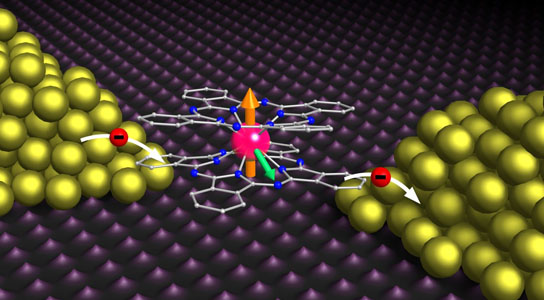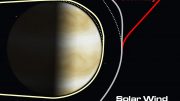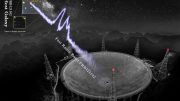
TbPc2 molecule quantum-bit device. Electrons (red) from the electrodes jump onto the molecule reading out the electronic spin (orange) and the nuclear spin (green). Credit: C. Grupe, KIT
In a newly published study, researchers from the Karlsruhe Institute of Technology and their colleagues have shown the first direct real-space images of spin-split molecular orbitals of a single-molecule magnet adsorbed on a ferromagnetic nanostructure.
Quantum computers promise to reach computation speeds far beyond that of today’s computers. As they would use quantum effects, however, they would also be susceptible to external interferences. Information flow into and out of the system is a critical point. Researchers from KIT with partners from Grenoble and Strasbourg have now read out the quantum state of an atom directly by using electrodes. A paper published in the Nature Communications journal reports on the stable interface between the classical and quantum world.
“Normally, every contact with the outer world changes information in a quantum mechanical system in a completely uncontrolled manner,” explains Professor Mario Ruben from Karlsruhe Institute of Technology. “We, therefore, have to keep the quantum state stable and shielded. On the other hand, information has to be read out in a controlled manner for further use.”
Magnetic molecule complexes may be a solution of this dilemma. In their center, a metal atom with a pronounced magnetic moment, a spin, is located. It is surrounded by organic molecules that shield the atom. “When synthesizing this protective enclosure, we can exactly define how much the metal atom sees of the outer world,” explains Ruben the trick of his research project.
The study presented is based on the metal atom terbium that was provided with an enclosure of about 100 carbon, nitrogen, and water atoms and then placed in the center of nanometer-sized, electric gold contacts. Due to the properties of the molecule, the electrodes had an effect similar to the three channels of a transistor. Electric voltage of the middle gate electrode influenced the current through the other two electrodes. In this way, the working point was set. Then, the molecule was exposed to various changing magnetic fields and the jump of the spin was reflected by the amplitude of the current curve. “By measuring current flow, we found that the nuclear spin of the metal atom is stable for up to 20 seconds,” says Ruben. “For quantum mechanical processes, this is a very long time.”
Ruben is sure that “the results will be of particular importance to spintronics and quantum computing.” Spintronics uses the magnetic spin of single particles for information processing. The word describes the symbiosis of spin and electronics. Quantum computers use quantum mechanical effects, such as the entanglement and super-position of spins, for the parallel execution of algorithms at high speed.
Reference: “Real-space observation of spin-split molecular orbitals of adsorbed single-molecule magnets” by Jörg Schwöbel, Yingshuang Fu, Jens Brede, Andrew Dilullo, Germar Hoffmann, Svetlana Klyatskaya, Mario Ruben and Roland Wiesendanger, 17 July 2012, Nature Communications.
DOI: 10.1038/ncomms1953








Be the first to comment on "Electronic Read-Out of the Quantum State of an Atom"